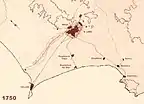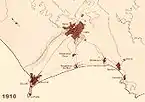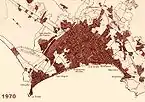The demographics of Lima can be reconstructed through the population censuses carried out throughout its history. The government statistics department estimates that a third of Peru's population lives in Lima.
Population by year
|
|
|
Ethnic groups
- Mestizos: 47%
- European: 40%
- Asian: 8%
- Amerindian: 2%
- Afro-Peruvian: 3%
Evolution of the Lima Metropolitan Area
- Evolution of the Lima Metropolitan Area
 1535
1535 1750
1750 1910
1910 1940
1940 1970
1970 1995
1995
References
- 1 2 Panfichi, Aldo. "La Urbanización de Lima" (PDF). Pontifica Universidad Católica del Perú. p. 19. Retrieved 23 March 2022.
This article is issued from Wikipedia. The text is licensed under Creative Commons - Attribution - Sharealike. Additional terms may apply for the media files.